Now that you know about the many types of physical activity and you’ve set your goals, you’re ready to go! This chapter has tips to help you get started, resume your activity if you’ve stopped, stay active, and even increase your activity level over time.
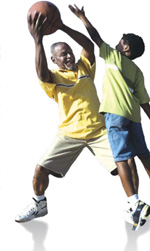 Three Keys to Success
Three Keys to Success
To help you get started and keep going, here are three ways to approach exercise and physical activity.
1. Include Physical Activity in Your Everyday Life
Physical activity needs to be a regular, permanent habit to produce benefits. Again, the key word is you. Set yourself up to succeed right from the start by choosing activities that appeal to you, exercising safely, charting your progress to see your success, and making your activity routine fit your personal lifestyle. Here are a few ways to make physical activity a regular part of your daily life.
Make it a priority. Many of us lead busy lives, and it’s easy to put physical activity at the bottom of the “to do” list. Remember, though, being active is one of the most important things you can do each day to maintain and improve your health. Make a point to include physical activities throughout your day. Try being active first thing in the morning before you get busy. Think of your time to exercise as a special appointment, and mark it on your calendar.
Make it easy. If it’s difficult or costs too much, you probably won’t be active. You are more likely to exercise if it’s easy to do. Put your 2-pound weights next to your easy chair so you can do some lifting while you watch TV. Walk up and down the soccer field during your grandchild’s game.
 Walk the entire mall or every aisle of the grocery store when you go shopping. When you go out to get the mail, walk around the block. Join a gym or fitness center that’s close to home. You can be active all at once, or break it up into smaller amounts throughout the day. Do more of the activities you already like and know how to do.
Walk the entire mall or every aisle of the grocery store when you go shopping. When you go out to get the mail, walk around the block. Join a gym or fitness center that’s close to home. You can be active all at once, or break it up into smaller amounts throughout the day. Do more of the activities you already like and know how to do.
Make it social. Enlist a friend or family member. Many people agree that having an “exercise buddy” keeps them going. Take a yoga class with a neighbor. If you don’t already have an exercise partner, find one by joining a walking club at your local mall or an exercise class at a nearby senior center. Take a walk during lunch with a co-worker.
Make it interesting and make it fun. Do things you enjoy and pick up the pace a bit. If you love the outdoors, try biking, fishing, jogging, or hiking. Listen to music or a book on CD while walking, gardening, or raking. Plan a hiking trip at a nearby park.
Above all, make it an active decision. Seize opportunities. Choose to be active in many places and many ways:

STICKING WITH IT: What Works
You’re more likely to stay active if you: - Think you will benefit from your activities
- Include activities you enjoy
- Feel you can do the activities correctly
- Believe the activities are safe
- Have regular access to the activities
- Can fit the activities into your daily schedule
- Find that the activities are affordable
- Can see the benefits of regular exercise and physical activity
|
When you unload the groceries, strengthen your arms by lifting the milk carton or a 1-pound can a few times before you put it away. - When you go shopping, build your endurance by parking the car at the far end of the parking lot and walking briskly to the store. Or, get off the bus one or two stops earlier than usual.
- Instead of calling or e-mailing a colleague at work, go in person — and take the stairs!
- Take a few extra trips up and down the steps at home to strengthen your legs and build endurance.
- Try to do some of your errands on foot rather than in the car.
- Multi-task the active way:
- While you’re waiting in line, practice your balancing skills by standing on one foot for a few seconds, then the other. Gradually build up your time.
- While you’re talking on the phone, stand up and do a few leg raises or toe stands to strengthen your legs.
- Take advantage of small bits of “down time” to do an exercise or two. For example, while you’re waiting for the coffee to brew or for your spouse to get ready to go out, do a few wall push-ups or calf stretches.
2. Try All Four Types of Exercise
Most people tend to focus on one activity or type of exercise and think they’re doing enough. The goal is to be creative and choose exercises from each of the four types we’ve talked about — endurance, strength, balance, and flexibility. Mixing it up will help you reap the benefits of each type of exercise, as well as reduce boredom and risk of injury. You can use the Weekly Exercise and Physical Activity Plan in Chapter 7 to write down your activities.

Finding enjoyable ways to add exercise to your life can be the ticket to success. See how Marian made it work for her:
“I’m an active 62-year-old, but a family history of heart disease and high cholesterol convinced me that I needed more exercise. After I tried walking on a treadmill at a nearby community center, I knew I’d be happier outside. So, I got a step counter and started walking in my neighborhood. I’ve seen purple tulips bloom in spring and red dogwood leaves drop in the fall. I always come home with more energy for the rest of my day."

If you’re thinking of moving to a retirement or assisted-living community, ask whether the community has a pool, exercise classes, walking trails, a golf course, or personal trainer. Does it have well-lit sidewalks so you can walk safely in the evening as well as during the day? Are there parks nearby?
|
If you lift weights, alternate these exercises with time on the treadmill or stationary bike. End your routine with stretching exercises.
If you focus mainly on endurance activities, be sure to add stretching, balance, or strength exercises to your routine. If you want to do strength exercises every day, alternate muscle groups, or exercise all of your muscle groups every other day. (See Weekly Exercise and Physical Activity Plan in Chapter 7.)
 3. Plan for Breaks in the Routine (Life Happens!)
3. Plan for Breaks in the Routine (Life Happens!)
Getting older can mean more time for trips to see children and grandchildren or vacations away from home. People retire and move to new houses or even new parts of the country. Sometimes the unexpected happens — family illness, caregiving responsibilities, or the death of a loved one. All of these events can interrupt your physical activity routines.
These breaks can make it hard or even impossible at times to stick with your regular activities. But you can start again. Here are a few ideas to help you stay active or start again if you’ve had to stop:
Don’t be too hard on yourself. Recognize that there will be times when you won’t want to exercise, or it feels too hard. You are not alone; everyone has those feelings. Just try to get back to your activities as soon as possible. The sooner you resume some sort of activity, the better you’ll feel, and the easier it will be to get back into your routine.
Talk with your doctor about when you can resume your regular routine if you stopped exercising because of an illness or new symptoms.
Think about the reasons you started exercising and the goals you set for yourself. Remembering your motivations and how much you’ve already accomplished may help recharge your batteries and get you started again.
Ask family and friends to help you get back on track. Sometimes, you may want an exercise buddy. At other times, all you may need is a word of support.
Try something easier or an activity you haven’t done recently if you don’t like the activity you started. You might even want to try something you’ve never done before. Mastering something simple or new may give you the confidence you need to resume a regular exercise program.
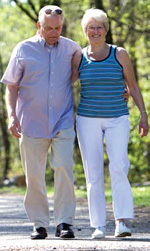 Talk with your doctor or trainer. You may get the boost you need to move past the hurdle.
Talk with your doctor or trainer. You may get the boost you need to move past the hurdle.
Start again at a comfortable level if you haven’t exercised for several weeks. Then gradually build back up. With a little time, you’ll be back on track.
Think creatively about other ways to exercise if you can’t do your regular physical activities because of bad weather or a change in your routine. For example, if caring for a loved one is keeping you indoors, try an exercise video, jog in place, dance around your living room, or walk up and down the stairs a few extra times. Just keep moving!
Be flexible. When your grandchildren come for a visit, reschedule your exercise during their nap time, or take them with you for a walk.
Believe in yourself! Feel confident that even if your activity is interrupted, you can start again and be successful. Don’t worry about the time you missed. What’s important is to focus on your fitness goals and start again at whatever level is possible for you.
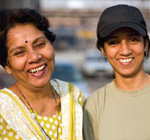 Walking Safely in Rural Areas Walking Safely in Rural Areas
Rural areas may have less traffic than big cities, but “a walk in the country” does require special care. Often the vehicles on rural roads travel at much higher speeds than pedestrians are used to, and drivers won’t expect to see someone walking on or near the side of the road. So, remember the following safety rules, and enjoy your walk! - Always walk facing oncoming traffic.
- Look for a smooth, stable surface alongside the road.
- If there are guardrails, see if there’s a smooth, flat surface behind the barrier where you can walk.
- If you need to walk on a paved shoulder, stay as far away from traffic as possible.
- Watch for bridges and narrow shoulders.
- Be sure drivers can see you. Wear brightly colored clothing, and if you walk during low-light hours — dusk or dawn — be sure you have reflective material on your jacket or walking shoes and carry a flashlight.
- Take along a cell phone and an ID, especially if walking alone.
|
 A few more tips on coping with breaks in your exercise routine
A few more tips on coping with breaks in your exercise routine
Sometimes the reason you have to stop exercising is temporary; sometimes it’s permanent. There may be a change in your living arrangements or in your health, for example. Some are happy occasions; some are sad. Here are some ways to manage these breaks.
| | Temporary | Permanent |
| A Change in Your Situation | You’re on vacation: - Many hotels now have fitness centers. Check out the facilities where you’ll be staying, and bring along your exercise clothing or equipment (resistance band, bathing suit, or walking shoes).
- Get out and see the sights on foot rather than just by tour bus.
Caring for an ill spouse is taking up much of your time: - Work out to an exercise video when your spouse is napping.
- Ask a family member or friend to come over so you can go for a walk.
| Your usual exercise buddy moves away: - Ask another friend to go with you on your daily walk.
- Ask other older adults in your area where they go for walks or what physical activity resources are available nearby.
- Join an exercise class at your local community center or senior center. This is a great way to meet other active people.
You move to a new community: - Check out the fitness centers, parks, and recreation associations in your new neighborhood.
- Look for activities that match your interests and abilities.
- Get involved!
|
| A Change in Your Health | The flu keeps you out of action for a few weeks: - Wait until you feel better and then start your activity again.
- Gradually build back up to your previous level of activity.
| You are recovering from hip or back surgery: - Talk with your doctor about specific exercises and activities you can do safely when you’re feeling better.
- Start slowly and gradually build up your activities as you become stronger.
|
Building Up the Benefits
Once you start exercising and becoming more physically active, you’ll begin to see results in just a few weeks — you’ll feel stronger and more energetic. You’ll notice that you can do things easier, faster, or for longer than before. This tells you that your body is getting used to a higher level of activity. Now is the time to build on those benefits by doing more. Keep your starting point in mind, though. For some people, switching from 1- to 2-pound weights is a big step forward. For others, building up to walking briskly or even running is a reasonable goal.
 No matter what your starting point:
No matter what your starting point:
- Add new physical activities. Be creative! Try some new activities to keep your interest alive. Sign up for dance lessons. Talk to your friends about bowling together once a week. Join a water aerobics class. Save gas by walking to your nearby grocery store. Can you trade in any of your electric appliances for muscle-powered versions: How about your electric can opener? Your electric lawn mower? Your electric leaf blower?
- Review your goals. If you are able, do your activities longer, farther, or harder. If you walk 30 minutes at lunch time every day, make it 40 minutes. If you only have 30 minutes for lunch, pick up the pace so you’re walking faster and farther in the same amount of time. Try using a pedometer, or step counter, to track your progress. Seeing the number of steps add up can be great motivation. If you usually swim half a mile, build up to three-quarters of a mile. Use a harder resistance band when you do strength exercises.
- Do the activities more often. Spend time in your garden more often. Head over to the gym three times a week instead of two. Walk every day.
|
 | go here for more info
Healthy eating and physical activity go hand in hand. See Chapter 6 for more on this topic. |
|
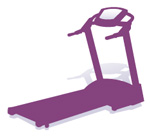
For many people, even those who exercise regularly, breaks in the routine mean the end of daily exercise and its benefits. Freddi tells how she carefully got started again:
“For more than 10 years, I jogged every day to clear the cobwebs and get my blood flowing. Imagine how awful I felt when I fell down the stairs and broke my ankle. At 54, I wasn’t ready to be a couch potato. After the cast came off, I had physical therapy. I worried about hurting my ankle again, but I wasn’t going to let the injury keep me down. At first, I walked slowly in my neighborhood, but I didn’t want to trip on uneven pavement. My physical therapist suggested I try a treadmill instead. Now, I go to the gym after work. I set the treadmill incline high, turn on my headphones, and walk. Sometimes, I listen to music or a book on CD. I miss the fresh air, but I don’t think about falling, and my stamina is back. Plus, I’ve added strength and balance exercises to my routine. In many ways, I’m in better shape now than before the fall and that feels great!”
Reducing the Risks
Many people hesitate to exercise for one reason or another. In fact, exercise and moderate physical activity, such as brisk walking, are safe for almost all older adults. Even so, avoiding injury is an important thing to keep in mind, especially if you’re just starting a new activity or you haven’t been active for a long time. Talk to your doctor if you have an ongoing health condition or certain other health problems or if you haven’t seen your doctor for a while. Ask how physical activity can help you, whether you should avoid certain activities, and how to modify exercises to fit your situation.
You may feel some minor discomfort or muscle soreness when you start to exercise. This should go away as you get used to the activities. However, if you feel sick to your stomach or have strong pain, you’ve done too much. Go easier and then gradually build up.
|
 | go here for more info
See Chapter 4 for more safety tips. |
|
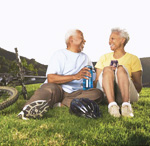 Preventing Injury Preventing Injury
The health benefits of exercise far outweigh any risks of injury. However, you can take some precautions to exercise safely. Follow these tips to avoid injury: - When starting an exercise program, begin slowly with low-intensity exercises.
- Wait at least 2 hours after eating a large meal before doing strenuous exercise.
- Wear appropriate shoes for your activity and comfortable, loose-fitting clothing that allows you to move freely but won’t catch on other objects.
- Warm up with low-intensity exercises at the beginning of each exercise session.
- Drink water before, during, and after your exercise session.
- When exercising outdoors, pay attention to your surroundings — consider possible traffic hazards, the weather, uneven walking surfaces, and strangers.
Stop exercising if you: - Have pain or pressure in your chest, neck, shoulder, or arm
- Feel dizzy or sick to your stomach
- Break out in a cold sweat
- Have muscle cramps
- Feel severe pain in joints, feet, ankles, or legs
|
<<Back | Next >>
